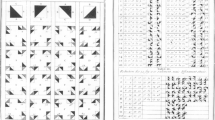Abstract
As additional multiple-point statistical (MPS) algorithms are developed, there is an increased need for scientific ways for comparison beyond the usual visual comparison or simple metrics, such as connectivity measures. In this paper, we start from the general observation that any (not just MPS) geostatistical simulation algorithm represents two types of variability: (1) the within-realization variability, namely, that realizations reproduce a spatial continuity model (variogram, Boolean, or training-image based), (2) the between-realization variability representing a model of spatial uncertainty. In this paper, it is argued that any comparison of algorithms needs, at a minimum, to be based on these two randomizations. In fact, for certain MPS algorithms, it is illustrated with different examples that there is often a trade-off: Increased pattern reproduction entails reduced spatial uncertainty. In this paper, the subjective choice that the best algorithm maximizes pattern reproduction is made while at the same time maximizes spatial uncertainty. The discussion is also limited to fairly standard multiple-point algorithms and that our method does not necessarily apply to more recent or possibly future developments. In order to render these fundamental principles quantitative, this paper relies on a distance-based measure for both within-realization variability (pattern reproduction) and between-realization variability (spatial uncertainty). It is illustrated in this paper that this method is efficient and effective for two-dimensional, three-dimensional, continuous, and discrete training images.













Similar content being viewed by others
References
Borg I, Lingoes J (1987) Multidimensional similarity structure analysis. Springer, New York
Borg I, Groenen P (1997) Modern multidimensional scaling: theory and applications. Springer, New York
Caers J, Strebelle S, Payrazyan K (2003) Stochastic integration of seismic data and geologic scenarios: a West Africa submarine channel saga. Lead Edge (Tulsa) 22(3):192–196
Caers J (2011) Modeling uncertainty in the Earth sciences. Wiley-Blackwell, New York, p 246
Caers J (2012) On internal consistency, conditioning and models of uncertainty. In: Ninth international geostatistics Congress, Oslo, Norway, June 11–15
Cover TM, Thomas JA (1991) Elements of information theory. Wiley-Interscience, New York, USA
Deutsch C, Gringarten E (2000) Accounting for multiple-point continuity in geostatistical modeling. In: 6th international geostatistics Congress of Southern Africa. vol 1. Geostatistics Association, Cape Town, pp 156–165
Dimitrakopoulos R, Mustapha H, Gloaguen E (2010) High-order statistics of spatial random fields: exploring spatial cumulants for modeling complex non-Gaussian and non-linear phenomena. Math Geosci 42(1):65–99
Endres DM, Schindelin JE (2003) A new metric for probability distributions. IEEE Trans Inf Theory 49(7):1858–1860
Heeger DJ, Bergen JR (1995) Pyramid-based texture analysis/synthesis. In: Proceedings of the 22nd annual conference on computer graphics and interactive techniques, pp 229–238
Honarkhah M, Caers J (2010) Stochastic simulation of patterns using distance-based pattern modeling. Math Geosci 42:487–517
Honarkhah M (2011) Stochastic simulation of patterns using distance-based pattern modeling. PhD dissertation, Stanford University, USA
Honarkhah M, Caers J (2012) Direct pattern-based simulation of non-stationary geostatistical models. Math Geosci 44:651–672
De Iaco S, Maggio S (2011) Validation techniques for geological patterns simulations based on variogram and multiple-point statistics. MathGeosci 43(4):483–500
Lange K, Frydendall J, Cordua KS, Hansen TM, Melnikova Y, Mosegaard K (2012) A frequency matching method: solving inverse problems by use of geologically realistic prior information. Math Geosci 44:783–803
Lekien F, Marsden J (2005) Tricubic interpolation in three dimensions. Int J Numer Methods Eng 63(3):455–471
Otsu N (1979) A threshold selection method from gray level histograms. IEEE Trans Syst Man Cybern 9:62–66
Remy N, Boucher A, Wu J (2009) Applied geostatistics with SGEMS: a user’s guide. Cambridge University Press, New York
Shawe-Taylor J, Cristianini N (2004) Kernel methods for pattern analysis. Cambridge University Press, Cambridge
Scheidt C, Caers J (2009) Representing spatial uncertainty using distances and kernels. Math Geosci 41(4):397–419
Schölkopf B, Smola AJ (2002) Learning with kernels: support vector machines, regularization, optimization, and beyond. MIT Press, Cambridge
Soleng HH, Syversveen HH, Kolbjørnsen O (2006) Comparing facies realizations: defining metrices on realization space. In: Ecmor X (ed) Proceedings of the 10th European conference in the mathematics of oil recovery, p A014. European Association of Geoscientists & Engineers
Strebelle S (2002) Conditional simulation of complex geological structures using multiple-point statistics. Math Geol 34(1):1–22
Strebelle S, Remy N (2005) Post-processing of multiple-point geostatistical models to improve reproduction of training patterns geostatistics Banff 2004. Quant Geol Geostat 14(5):979–988
Suzuki S, Caers J (2008) A distance-based prior model parameterization for constraining solutions of spatial inverse problems. Math Geosci 40(4):445–469
Tahmasebi P, Hezarkhani A, Sahimi M (2012) Multiple-point geostatistical modeling based on the cross-correlation functions. Comput Geosci 16:779–797
Acknowledgements
We appreciate the discussions on distances derived from frequency tables with Katrine Lange of the Technical University of Denmark during her visit at Stanford University. The code for this paper is freely available at http://github.com/SCRFpublic/ANODI.
Author information
Authors and Affiliations
Corresponding author
Rights and permissions
About this article
Cite this article
Tan, X., Tahmasebi, P. & Caers, J. Comparing Training-Image Based Algorithms Using an Analysis of Distance. Math Geosci 46, 149–169 (2014). https://doi.org/10.1007/s11004-013-9482-1
Received:
Accepted:
Published:
Issue Date:
DOI: https://doi.org/10.1007/s11004-013-9482-1




